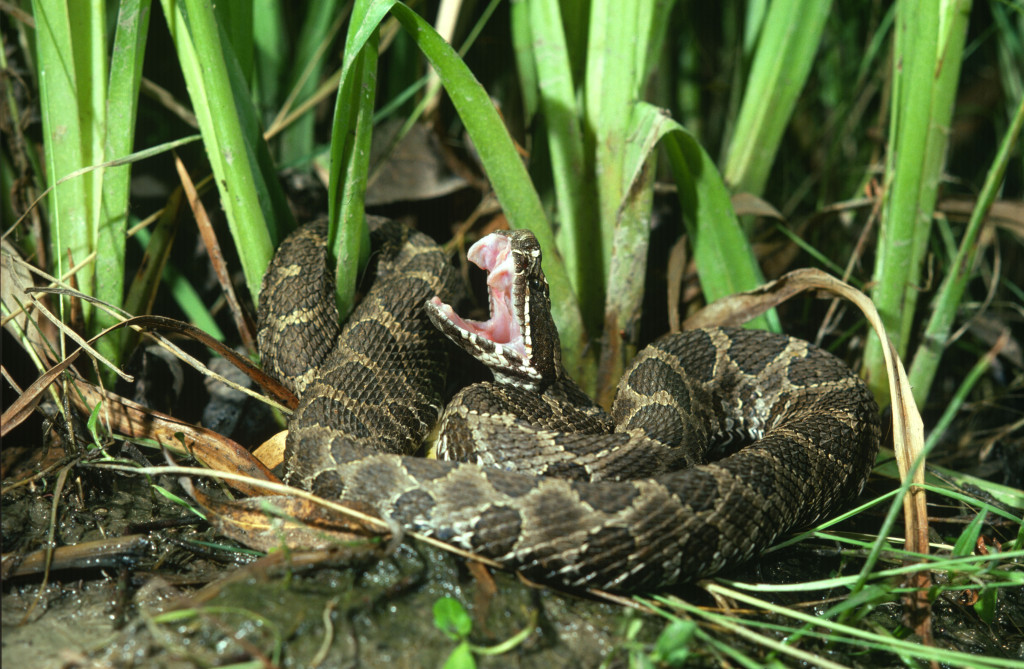
By Monica Macoubrie, Wildlife Education Specialist
As an outdoor educator, I hear a lot of discussion about the “poisonous” snakes in Nebraska. Actually, the correct term is venomous snakes, not poisonous. Although both poison and venom can cause death or serious impairment to the function of organs and/or living tissues, these two terms cannot be used interchangeably: Poisons are toxins that are ingested or inhaled, such as a plant or substance; whereas venom is a toxin that is injected, most commonly through a bite or sting. So, while all venoms are poisons, not all poisons are venoms. Let’s take a closer look.
What is venom?
Venom is a collection of various toxins and enzymes. This could include proteins, metals and ions, glycoproteins, lipids, amino acids, enzymes and toxins. There have been at least 26 different enzymes identified in snake venom, but no single snake venom cocktail contains all enzymes. Therefore, not all snake venom is created equal. Venom composition depends on the species of snake, the age of the animal, and it is also contingent on where the species is located geographically. Ultimately, the structure of a snake’s venom is dependent on the type of prey the animal eats. Scientists often categorize snake venom as either neurotoxic or hemotoxic.
Neurotoxic venoms are predominately used by elapid snakes, such as cobras and their kin. These snakes use proteroglyphs (fixed) front fangs to deliver this venom. The amino acids disrupt neuromuscular junctions (action site of transmission from nerve to muscle) and inhibit synaptic (nerve cell signaling) activity. Neurotoxic venoms kill prey by respiratory shock and paralysis. This venom is of lower molecular weight than hemotoxic venoms, so it diffuses more easily into cells and acts faster. This type of venom is most effective on ectothermic, or cold-blooded, prey, such as lizards, other snakes and fish.
Hemotoxic venoms are predominantly utilized by vipers and pit vipers (rattlesnakes), which have solenoglyphous front fangs that fold down and opisthoglyphous fangs, which are enlarged, grooved fangs that angle backward. With hemotoxic venoms, the enzymes and toxins act to inhibit hemostasis, or the ability to stop the flow of blood. Targeted prey are normally warm-blooded, and death is achieved in a multi-step process that affects the circulatory and cardiovascular systems, including hypotension (low blood pressure) followed by heart and/or organ failure.
What is the purpose of venom?
Snakes have venom for several reasons. The first reason is to immobilize prey. Another purpose for venom is digestion, and this may be the main reason some snakes initially evolved to produce venom. Snakes often eat large food items, which can reduce their mobility while digesting. This makes them vulnerable to being eaten by bigger predators. Venom aids digestion by beginning the process within the prey item; prey essentially break down from the inside out, thus reducing the time it takes for a snake to digest it.
Many people think snakes use venom for defense, but that is rarely true. Venom is “expensive” for the snake’s body to make, so they often don’t waste it on non-prey items. For all snakes, venomous or not, their first defense tactic is to flee. And if that doesn’t work, they may hiss, rattle their tail, sometimes use a technique called “hooding” (like our hognose snakes) to make themselves appear bigger, or even make false strikes to say, “Please stay away.” Strikes with venom injection are normally an extreme, last resort.
How is venom injected?
The venom delivery system in snakes contains four things: glands to produce the venom, muscles to force the venom out of the glands, ducts to transport venom from the gland to the injection system, and fangs to inject the venom into the prey item. Fangs act like a hypodermic needle, forcing the venom into the prey with pressure, and different species have different styles of doing so. In some species, there is a groove at the front of the fang, and not at the tip, like many people believe.
Venom is continuously produced and stored in the venom-gland chambers. Each snake can regulate the amount of venom injected depending on the size of the prey and the amount of venom available.
Which venomous snakes can be found in Nebraska?
In Nebraska, we have 30 species of snakes, and of those species, only four of them are venomous. They are the prairie rattlesnake (Crotalus viridis), massasauga rattlesnake (Sistrurus catenatus), timber rattlesnake (Crotalus horridus) and copperhead (Agkistrodon contortrix). Look for a follow-up article on Nebraska’s venomous snakes.
